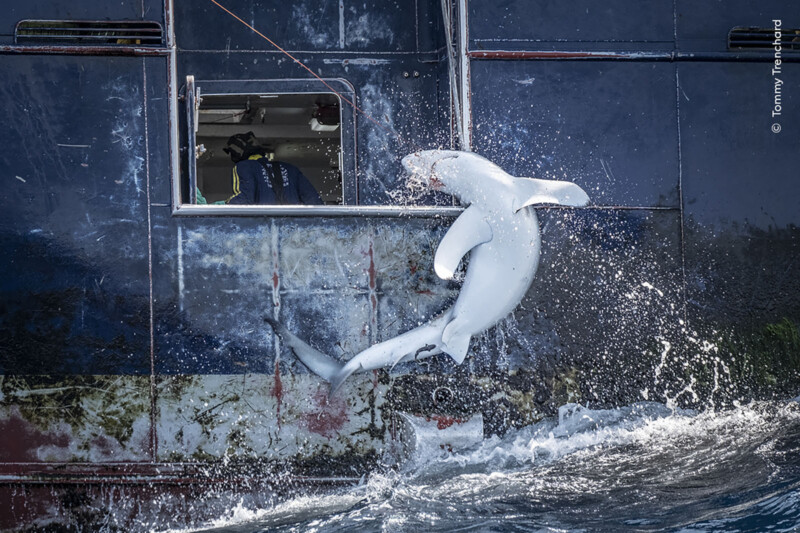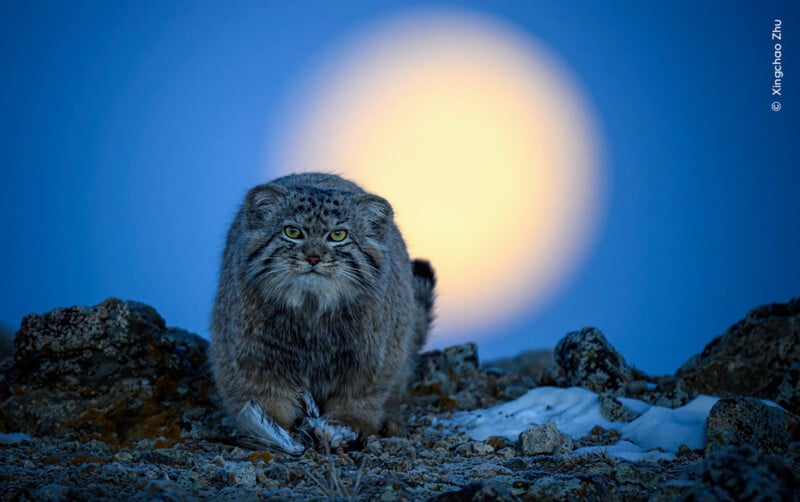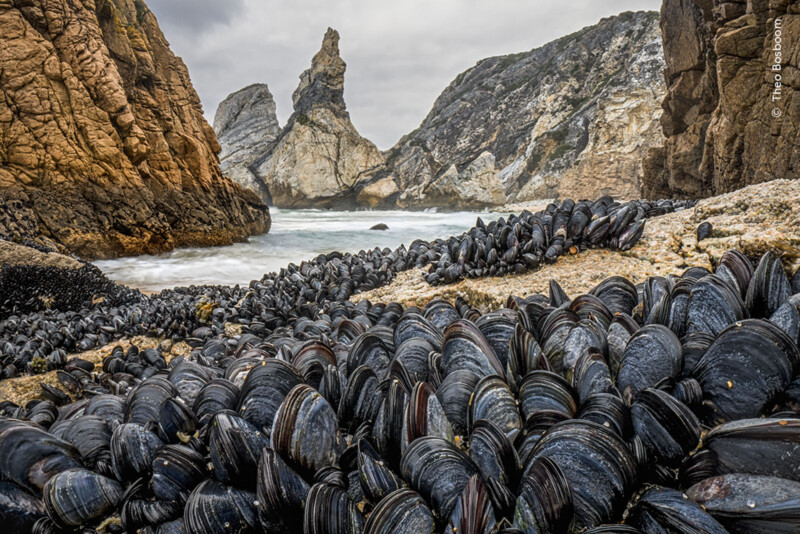 Mating lions in the Serengeti National Park bicker in front of a dramatic sky. | William Fortescue / Wildlife Photographer of the Year
Mating lions in the Serengeti National Park bicker in front of a dramatic sky. | William Fortescue / Wildlife Photographer of the Year These spellbinding photographs have all been Highly Commended in the sixtieth Wildlife Photographer of the Year competition held by London’s Natural History Museum.
The landmark edition of the contest attracted a record-breaking 59,228 entries from photographers of all ages and experience levels from 117 different countries and territories.
The finalists include an image taken on an iPhone XR — marking the first time a smartphone photographer has made it to the Highly Commended level. The striking photo, taken by Randy Robbins, shows a frozen deer in California.
 A stoat leaps into the air above a snowy scene in France. Scientists refer to this behavior as dancing, although opinions are divided about what motivates it, from an attempt to confuse prey through to a parasitic infection. Stoats are usually active at night and prey on small mammals and birds. | Jose Manuel Grandío / Wildlife Photographer of the Year
A stoat leaps into the air above a snowy scene in France. Scientists refer to this behavior as dancing, although opinions are divided about what motivates it, from an attempt to confuse prey through to a parasitic infection. Stoats are usually active at night and prey on small mammals and birds. | Jose Manuel Grandío / Wildlife Photographer of the Year  Male Dawson’s burrowing bees vye for access to a female in Australia. Georgina has been studying these bees for a few years and knew she had to keep her distance. Lying on the hot, rocky, sun-baked ground with sand blowing in her face, her long lens enabled her to get the perfect image. When female Dawson’s burrowing bees emerge in spring, they are surrounded by males competing to mate with them. After mating, the female bee will dig a new burrow filled with pollen and eggs, from which the hatched bees will emerge in spring. | Georgina Steytler / Wildlife Photographer of the Year
Male Dawson’s burrowing bees vye for access to a female in Australia. Georgina has been studying these bees for a few years and knew she had to keep her distance. Lying on the hot, rocky, sun-baked ground with sand blowing in her face, her long lens enabled her to get the perfect image. When female Dawson’s burrowing bees emerge in spring, they are surrounded by males competing to mate with them. After mating, the female bee will dig a new burrow filled with pollen and eggs, from which the hatched bees will emerge in spring. | Georgina Steytler / Wildlife Photographer of the Year  A jaguar delivers a fatal bite to a caiman in the Pantanal, Brazil. A call over the radio alerted photographer Ian Ford that a jaguar had been spotted prowling the banks of a São Lourenço River tributary. Kneeling in the boat, he was perfectly placed when the cat delivered the skull-crushing bite to the unsuspecting Yacare caiman. The South American Pantanal wetland supports the highest density of jaguars anywhere in the world. With prey being so abundant, there is no need to compete for food, and the usually solitary big cats have been seen fishing, traveling and playing together. | Ian Ford / Wildlife Photographer of the Year
A jaguar delivers a fatal bite to a caiman in the Pantanal, Brazil. A call over the radio alerted photographer Ian Ford that a jaguar had been spotted prowling the banks of a São Lourenço River tributary. Kneeling in the boat, he was perfectly placed when the cat delivered the skull-crushing bite to the unsuspecting Yacare caiman. The South American Pantanal wetland supports the highest density of jaguars anywhere in the world. With prey being so abundant, there is no need to compete for food, and the usually solitary big cats have been seen fishing, traveling and playing together. | Ian Ford / Wildlife Photographer of the Year  The frozen body of a deer lies on the forest floor near Susanville, California. Taken on an iPhone XR. | Randy Robbins / Wildlife Photographer of the Year
The frozen body of a deer lies on the forest floor near Susanville, California. Taken on an iPhone XR. | Randy Robbins / Wildlife Photographer of the Year  This requiem shark is the victim of a bycatch. Photographer Tommy Trenchard was on a Greenpeace ship documenting the accidental capture of sharks by fishing boats targeting tuna and swordfish. Approximately 80 million sharks are taken from the world’s oceans every year. Because of fishing, numbers of sharks worldwide has dropped since 1970. Three-quarters of all shark species are now at risk of extinction. | Tommy Trenchard / Wildlife Photographer of the Year
This requiem shark is the victim of a bycatch. Photographer Tommy Trenchard was on a Greenpeace ship documenting the accidental capture of sharks by fishing boats targeting tuna and swordfish. Approximately 80 million sharks are taken from the world’s oceans every year. Because of fishing, numbers of sharks worldwide has dropped since 1970. Three-quarters of all shark species are now at risk of extinction. | Tommy Trenchard / Wildlife Photographer of the Year  The Moon sets behind a Pallas’s cat on a freezing plateau in Mongolia as the feline sits pretty with its catch. The thick winter coats of Pallas’s cats help them survive at altitudes up to 5,000 meters (16,400 feet). They avoid larger predators by stealth, and it’s thought that their low, rounded ears allow them to peer over obstacles while remaining hidden. | Xingchao Zhu / Wildlife Photographer of the Year
The Moon sets behind a Pallas’s cat on a freezing plateau in Mongolia as the feline sits pretty with its catch. The thick winter coats of Pallas’s cats help them survive at altitudes up to 5,000 meters (16,400 feet). They avoid larger predators by stealth, and it’s thought that their low, rounded ears allow them to peer over obstacles while remaining hidden. | Xingchao Zhu / Wildlife Photographer of the Year  Two Indian peafowl in an idyllic forest in Rajasthan, India. Runner up in the 10 Years and Under category. | Shreyovi Mehta / Wildlife Photographer of the Year
Two Indian peafowl in an idyllic forest in Rajasthan, India. Runner up in the 10 Years and Under category. | Shreyovi Mehta / Wildlife Photographer of the Year  Two tawny outlets people watch from a branch in Munich, Germany. Highly Commended in the 10 Years and Under category. | Sasha Jumanca / Wildlife Photographer of the Year
Two tawny outlets people watch from a branch in Munich, Germany. Highly Commended in the 10 Years and Under category. | Sasha Jumanca / Wildlife Photographer of the Year  A David Bowie spider (not from Mars) carries an egg sac in the highlands of Malaysia. Found in Malaysia, Singapore, and the Indonesian island of Sumatra, this spider was named in 2008 by arachnologist and Bowie fan Dr Peter Jäger. He thought the striking markings up to the spider’s head region resembled the make-up worn by the singer during the 1970s. | Lam Soon Tak / Wildlife Photographer of the Year
A David Bowie spider (not from Mars) carries an egg sac in the highlands of Malaysia. Found in Malaysia, Singapore, and the Indonesian island of Sumatra, this spider was named in 2008 by arachnologist and Bowie fan Dr Peter Jäger. He thought the striking markings up to the spider’s head region resembled the make-up worn by the singer during the 1970s. | Lam Soon Tak / Wildlife Photographer of the Year  A jackdaw bringing stones to its nest in London’s Bushy Park. | Samual Stone / Wildlife Photographer of the Year
A jackdaw bringing stones to its nest in London’s Bushy Park. | Samual Stone / Wildlife Photographer of the Year  Crabeater seals move among the sea ice in the Antarctic. | Tamara Stubbs / Wildlife Photographer of the Year
Crabeater seals move among the sea ice in the Antarctic. | Tamara Stubbs / Wildlife Photographer of the Year  Mussels bind together to avoid being washed away from the shoreline in Portugal. Mussels play an important role in creating dynamic ecosystems for other marine invertebrates such as crustaceans, worms, and even small fish. They improve the water quality by filter-feeding, and extracting plankton as well as bacteria and toxins, which prevents them from building up to dangerous levels. | Theo Bosboom / Wildlife Photographer of the Year
Mussels bind together to avoid being washed away from the shoreline in Portugal. Mussels play an important role in creating dynamic ecosystems for other marine invertebrates such as crustaceans, worms, and even small fish. They improve the water quality by filter-feeding, and extracting plankton as well as bacteria and toxins, which prevents them from building up to dangerous levels. | Theo Bosboom / Wildlife Photographer of the Year  Thomas Vijayan utilizes his drone to show the epic scale of the Bråsvellbreen glacier. Encapsulating the magnificence of the Austfonna ice cap required meticulous planning and favorable weather conditions. Thomas’s image, a stitched panorama of 26 individual frames, provides a spectacular summer view of meltwater plunging over the edge of the Bråsvellbreen glacier. | Thomas Vijayan / Wildlife Photographer of the Year
Thomas Vijayan utilizes his drone to show the epic scale of the Bråsvellbreen glacier. Encapsulating the magnificence of the Austfonna ice cap required meticulous planning and favorable weather conditions. Thomas’s image, a stitched panorama of 26 individual frames, provides a spectacular summer view of meltwater plunging over the edge of the Bråsvellbreen glacier. | Thomas Vijayan / Wildlife Photographer of the Year The winners of the Wildlife Photographer of the Year competition will be announced on October 8 at a ceremony. Then, from October 11, 100 photographs from the contest will be displayed at the Natural History Museum in London. An exhibition marking the key moments from the competition’s 60-year history will run concurrently.